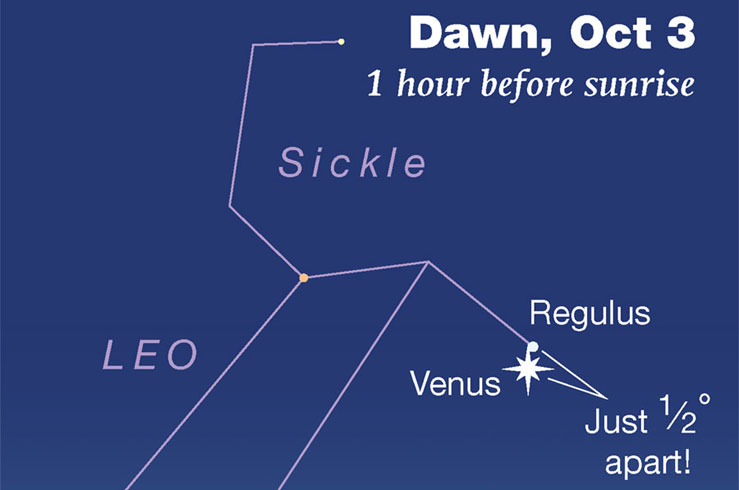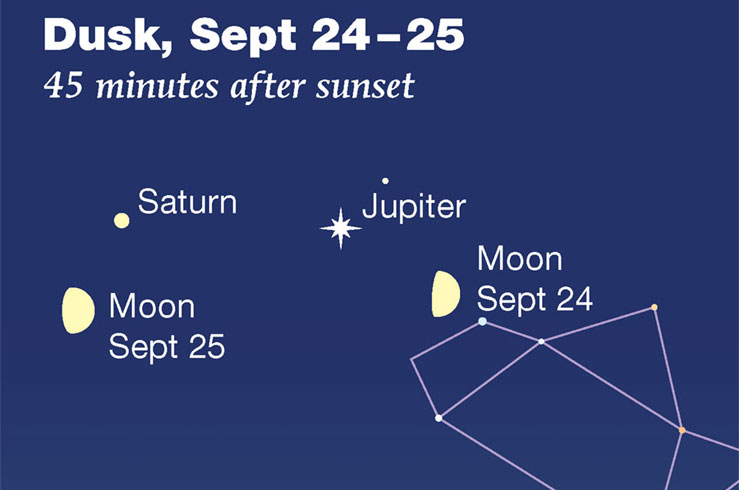
This Weeks' Sky at a Glance, October 16 – 24
Mars is edging away a bit now from its close approach to Earth, but on the other hand, it rises higher into fine telescopic view earlier in the night.

This Week's Sky at a Glance, October 9 – 17
Mars comes to opposition on October 13th. Although it was closest to Earth on the 6th, it is still at virtually the same distance all week, remaining 22.5 to 22.0 arcseconds in apparent diameter. This is bigger than we will see it again until September 2035.

This Week's Sky at a Glance, October 2 – 10
Mars is closer this week than it will be until 2035! The Moon pairs up closely with Mars on Friday the 2nd — and occults Mars for parts of South America. Jupiter and Saturn, meanwhile, remain at their highest and best right around nightfall, lower in the south.

This Week's Sky at a Glance, September 25 – October 3
The Moon waxes through first quarter to gibbous this week, passing Jupiter and Saturn along the way. And by the end of twilight, Jupiter-bright Mars glares low in the east. It's big, bold, and almost at opposition!

This Week's Sky at a Glance, September 18 – 26
Jupiter and Saturn continue shining nearly level in the south at dusk. Meanwhile, the stars show the changing of the seasons: Just after nightfall, Cassiopeia has climbed higher in the northeast than the Big Dipper has sunk in the northwest.

This Week's Sky at a Glance, September 11 – 19
Vega passes the zenith in late twilight. Vega is bigger, hotter, and 50 times brighter than our Sun. But at a distance of 25 light-years, it's 1.6 million times farther away. Jupiter and Saturn still dominate the south at dusk. And fiery Mars, close and almost Jupiter-bright, rises in the east around the end of twilight. It's at its highest and telescopic best in the south around 3 a.m. daylight-saving time.

This Week's Sky at a Glance, September 4 – 12
Mars is big, bright and close as it nears opposition! It nears the gibbous Moon this weekend.

This Week's Sky at a Glance, August 28 – September 5
Betelgeuse is dimming again. . . somewhat. After its historic fade last winter to magnitude +1.6, Orion's red supergiant Betelgeuse fully recovered, to +0.4, before it disappeared into the sunset for the season. But now as it emerges low in the east before dawn, it seems to have faded back…

This Week's Sky at a Glance, August 21 – 29
After dark, Jupiter and Saturn shine in the southeast to south, lined up almost level now. And Fomalhaut, the Autumn Star, is making its inevitable appearance above the southeast horizon.

This Week's Sky at a Glance, August 14 – 22
Jupiter and Saturn line up level in the south earlier in the evening now, as summer proceeds. How early in twilight can you see them both? High upper left of them shines Altair. As night comes on, look for the Sagittarius Teapot to Jupiter's lower right.

This Week's Sky at a Glance, August 7 – 15
It's Perseid meteor week! The shower peaks on the night of August 11th, but you may see the occasional Perseid any night and perhaps already have. Jupiter and Saturn shine in the southeast after dark. Bright Vega passes closest to overhead around 10 or 11 p.m.

This Week's Sky at a Glance, July 31 – August 8
Mars rises in the east around 11 p.m. daylight saving time this week, in Pisces. Watch for it to come up below the Great Square of Pegasus.

This Week's Sky at a Glance, July 24 – August 1
All this summer, there's no missing Jupiter and Saturn on any clear evening. Jupiter is the brightest point in the evening sky. Saturn is left of it.

This Week's Sky at a Glance, July 17 – 25
The waxing crescent Moon swells back into the evening sky this week, and Jupiter and Saturn are at opposition on the nights of July 13th and 20th, respectively.

This Week's Sky at a Glance, July 10 – 18
Jupiter and Saturn rise in twilight this week. Mars is a fire-beacon high in the southeast by the beginning of dawn. Venus, low as dawn begins to brighten, passes just 1° from Aldebaran on Saturday and Sunday mornings July 11th and 12th.

This Week's Sky at a Glance, July 3 – 11
This is the time of year when the two brightest stars of summer, Arcturus and Vega, are equally high overhead at dusk. Arcturus is toward the southwest, Vega is toward the east.

This Week's Sky at a Glance, June 26 – July 4
Every morning now, Venus is getting a little higher and easier to spot in the east-northeast as dawn brightens

This Week's Sky at a Glance, June 19 – 27
Leo the Lion is mostly a constellation of late winter and spring. But he's not gone yet. As twilight ends look due west, somewhat low, for Regulus, his brightest and now lowest star: the forefoot of the Lion stick figure. The Sickle of Leo extends upper right from Regulus. The rest of the Lion's constellation figure extends for almost three fists to the upper left, to his tail star Denebola, the highest. He'll soon be treading away into the sunset.

This Week's Sky at a Glance, June 12 – 20
As we count down the days to official summer (the solstice is June 20th), the big Summer Triangle shines high and proud in the east after dark. Its top star is bright Vega. Deneb is the brightest star to Vega's lower left. Look for Altair farther to Vega's lower right.

This Week's Sky at a Glance, June 5 – 13
FRIDAY, JUNE 5 ■ Catch Mercury in twilight! It's under Pollux and Castor this week, as shown below. Mercury is ending its last good evening showing until winter 2021. Mercury is still visible in the western twilight, under the heads of Gemini, but it's fading. This scene is drawn for…
